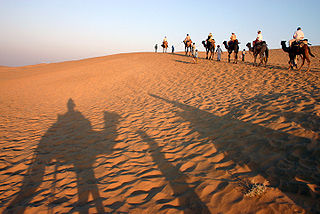Rajasthan

Rajasthan literally, “Land of Kings” is India’s largest state by area (342,239 square kilometres (132,139 sq mi) or 10.4% of India’s total area). It is located on the western side of the country, where it comprises most of the wide and inhospitable Thar Desert (also known as the “Rajasthan Desert” and “Great Indian Desert”) and shares a border with the Pakistani provinces of Punjab to the northwest and Sindh to the west, along the Sutlej-Indus river valley. Elsewhere it is bordered by the other Indian states: Punjab to the north; Haryana and Uttar Pradesh to the northeast; Madhya Pradesh to the southeast; and Gujarat to the southwest. Rajasthan is divided into 9 regions; Ajmer State, Hadoti, Dhundhar, Gorwar, Shekhawati, Mewar, Marwar, Vagad and Mewat which are equally rich in its heritage and artistic contribution. These regions have a parallel history which goes along with that of the state.
Major features include the ruins of the Indus Valley Civilization at Kalibanga; the Dilwara Temples, a Jain pilgrimage site at Rajasthan’s only hill station, Mount Abu, in the ancient Aravalli mountain range; and, in eastern Rajasthan, the Keoladeo National Park near Bharatpur, a World Heritage Site known for its bird life. Rajasthan is also home to two national tiger reserves, the Rathanbore National Park in Sawai Madhopur and Sariska Tiger Reserve in Alwar.
The state was formed on 30 March 1949 when Rajputana – the name adopted by the British Raj for its dependencies in the region – was merged into the Dominion of India. Its capital and largest city is Jaipur also known as Pink City, located on the state’s eastern side. Other most important cities are Jodhpur, Udaipur, Bikaner, Kota and Ajmer.
Source : Wikipedia

















Places Of Interest